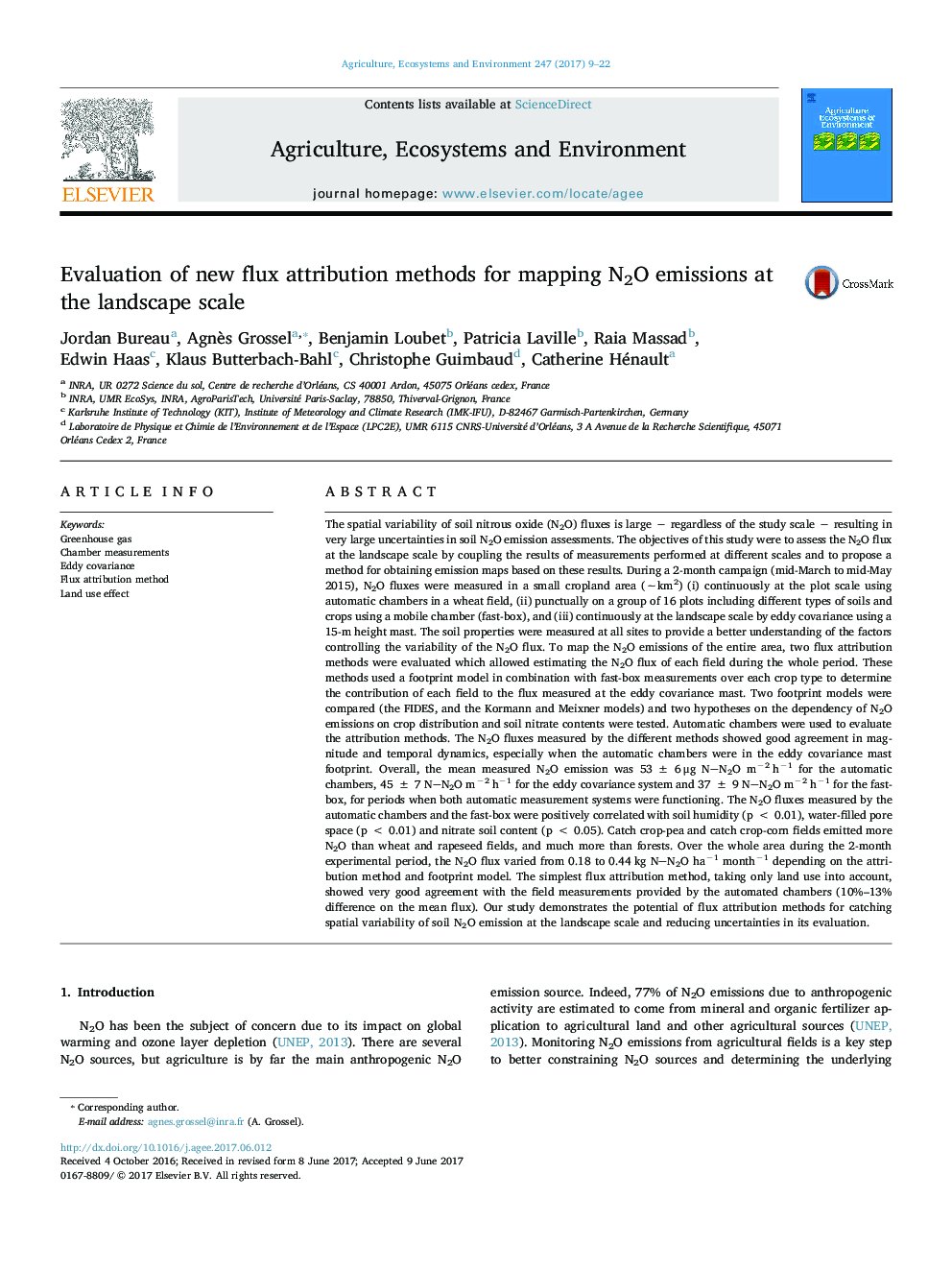| کد مقاله | کد نشریه | سال انتشار | مقاله انگلیسی | نسخه تمام متن |
|---|---|---|---|---|
| 5537973 | 1552005 | 2017 | 14 صفحه PDF | دانلود رایگان |
عنوان انگلیسی مقاله ISI
Evaluation of new flux attribution methods for mapping N2O emissions at the landscape scale
دانلود مقاله + سفارش ترجمه
دانلود مقاله ISI انگلیسی
رایگان برای ایرانیان
موضوعات مرتبط
علوم زیستی و بیوفناوری
علوم کشاورزی و بیولوژیک
علوم زراعت و اصلاح نباتات
پیش نمایش صفحه اول مقاله

چکیده انگلیسی
The spatial variability of soil nitrous oxide (N2O) fluxes is large â regardless of the study scale â resulting in very large uncertainties in soil N2O emission assessments. The objectives of this study were to assess the N2O flux at the landscape scale by coupling the results of measurements performed at different scales and to propose a method for obtaining emission maps based on these results. During a 2-month campaign (mid-March to mid-May 2015), N2O fluxes were measured in a small cropland area (â¼km2) (i) continuously at the plot scale using automatic chambers in a wheat field, (ii) punctually on a group of 16 plots including different types of soils and crops using a mobile chamber (fast-box), and (iii) continuously at the landscape scale by eddy covariance using a 15-m height mast. The soil properties were measured at all sites to provide a better understanding of the factors controlling the variability of the N2O flux. To map the N2O emissions of the entire area, two flux attribution methods were evaluated which allowed estimating the N2O flux of each field during the whole period. These methods used a footprint model in combination with fast-box measurements over each crop type to determine the contribution of each field to the flux measured at the eddy covariance mast. Two footprint models were compared (the FIDES, and the Kormann and Meixner models) and two hypotheses on the dependency of N2O emissions on crop distribution and soil nitrate contents were tested. Automatic chambers were used to evaluate the attribution methods. The N2O fluxes measured by the different methods showed good agreement in magnitude and temporal dynamics, especially when the automatic chambers were in the eddy covariance mast footprint. Overall, the mean measured N2O emission was 53 ± 6 μg NN2O mâ2 hâ1 for the automatic chambers, 45 ± 7 NN2O mâ2 hâ1 for the eddy covariance system and 37 ± 9 NN2O mâ2 hâ1 for the fast-box, for periods when both automatic measurement systems were functioning. The N2O fluxes measured by the automatic chambers and the fast-box were positively correlated with soil humidity (p < 0.01), water-filled pore space (p < 0.01) and nitrate soil content (p < 0.05). Catch crop-pea and catch crop-corn fields emitted more N2O than wheat and rapeseed fields, and much more than forests. Over the whole area during the 2-month experimental period, the N2O flux varied from 0.18 to 0.44 kg NN2O haâ1 monthâ1 depending on the attribution method and footprint model. The simplest flux attribution method, taking only land use into account, showed very good agreement with the field measurements provided by the automated chambers (10%-13% difference on the mean flux). Our study demonstrates the potential of flux attribution methods for catching spatial variability of soil N2O emission at the landscape scale and reducing uncertainties in its evaluation.
ناشر
Database: Elsevier - ScienceDirect (ساینس دایرکت)
Journal: Agriculture, Ecosystems & Environment - Volume 247, 1 September 2017, Pages 9-22
Journal: Agriculture, Ecosystems & Environment - Volume 247, 1 September 2017, Pages 9-22
نویسندگان
Jordan Bureau, Agnès Grossel, Benjamin Loubet, Patricia Laville, Raia Massad, Edwin Haas, Klaus Butterbach-Bahl, Christophe Guimbaud, Catherine Hénault,